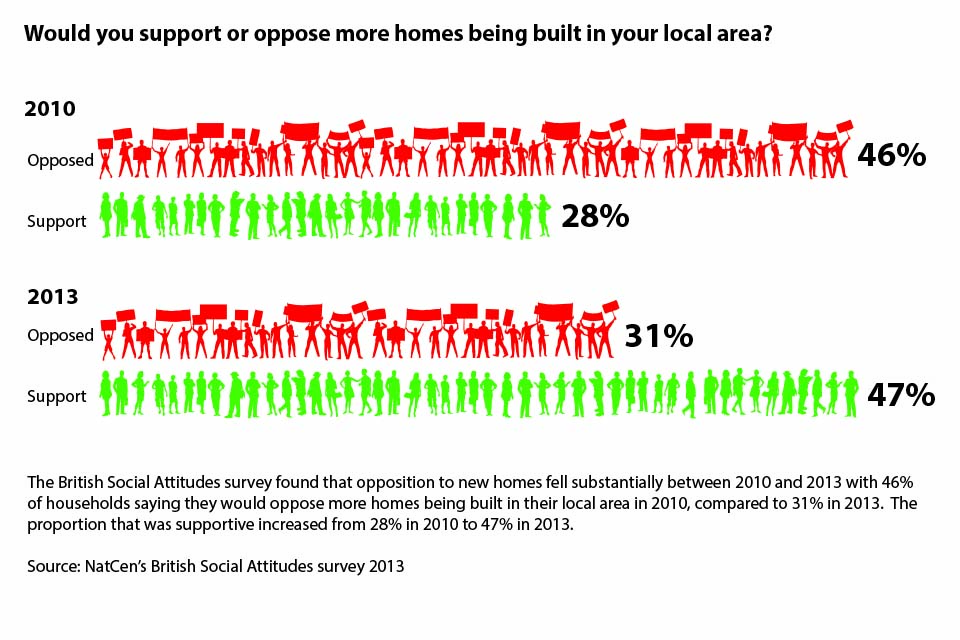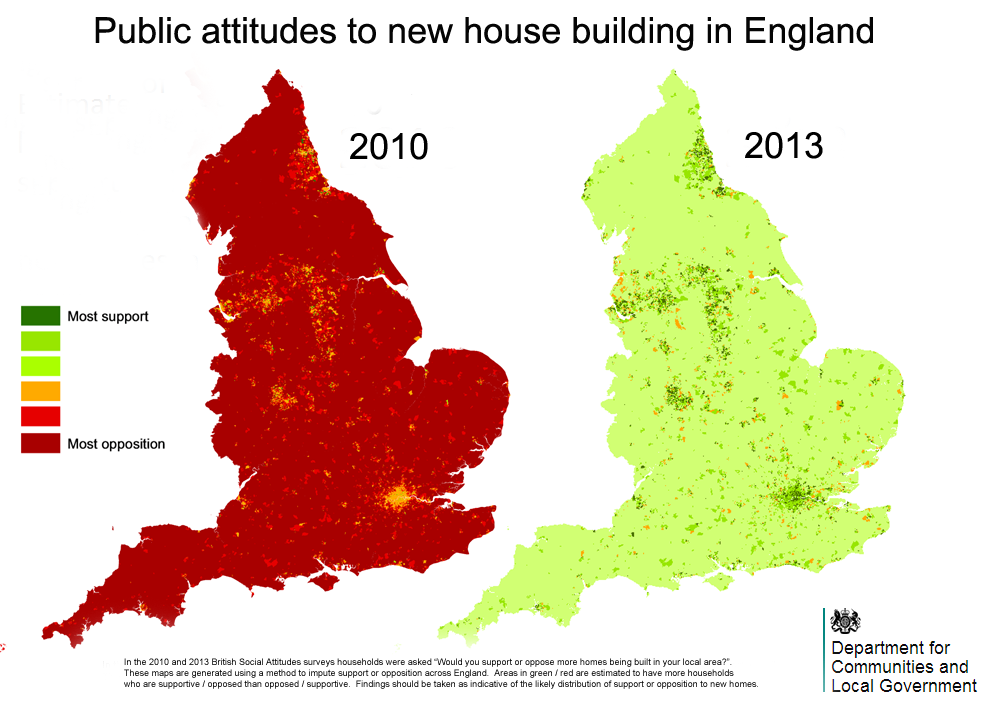Public attitudes to new house building: Findings from the 2013 British Social Attitudes Survey
[edit] Introduction
On 26 July 2014, the Department for Communities and Local Government, published Public attitudes to new house building: Findings from the 2013 British Social Attitudes Survey setting out the findings from a number of public attitude questions asked within the British Social Attitudes (BSA) survey 2013.
The report shows clear evidence that attitudes to new housing are changing with a generally more positive response than in previous surveys. The key findings of the report are reproduced below.
[edit] Key findings
Opposition to new homes fell substantially between 2010 and 2013, with 46 per cent of respondents saying they would oppose new homes being built in their local area in 2010, compared to 31 per cent in 2013. The proportion that was supportive increased from 28 per cent in 2010 to 47 per cent in 2013.
Net opposition (percentage of those saying they are opposed minus those saying they are supportive) has reduced from 18 per cent in 2010 to -16 per cent. The strength of opposition for new homes has also decreased. The proportion of respondents stating they would strongly oppose new homes being built in their local area almost halved from 15 per cent in 2010 to 8 per cent in 2013. At the same time the proportion of respondents who said they would strongly support new homes more than doubled from 5 per cent to 11per cent.
Opposition fell across all age, tenure and income subgroups and among respondents living in different types of areas. However, home owners, those living in small cities and towns and in rural areas were still more likely to be opposed than renters and those living in large cities.
When respondents who were not supportive of new homes were asked which of the potential benefits from new housing would make them more supportive, they most commonly selected more employment opportunities (17 per cent), more low cost homeownership (11 per cent) and more or improved medical facilities (11 per cent).
When all respondents were asked if they would be more supportive of new homes if the “government provided local councils with more money to spend on local services for every new home built”, almost half (47 per cent) said this would make them more supportive.
A majority of respondents thought that a more localist planning system would make them more supportive of new homes. Sixty-three per cent of respondents said they would be more supportive if “local people were given greater control and say over what gets built in their local area”.
When asked “if the government brought in changes so that when people from a local community come together to get involved in planning for new development, that community can receive extra money to be spent locally”, 57 per cent said this would make them more supportive.
Thirty-eight per cent of respondents agreed whether they support new homes being built in their local area “depended on their design”. Forty-eight per cent agreed that “properties built in the last decade were better or much better designed, in terms of their external appearance, compared to those built around 20 or 30 years ago”. Twenty-seven per cent thought design was worse or much worse.
Eighty-two per cent of respondents agreed “there is a shortage of homes that are affordable to buy in England”, with 73 per cent agreeing there is a shortage “in my local area”. Eighty-three per cent felt it was more difficult (49 per cent) or much more difficult (33 per cent) to buy their own home today compared to 20 years ago.
Views were mixed whether building more homes would improve affordability. Forty per cent agreed with the statement “building more homes would improve the affordability of housing in my local area” while 55 per cent agreed that homes “would continue to be unaffordable in my local area even if new homes are built.”
This article contains public sector information licensed under the Open Government Licence v2.0 ref Department for Communities and Local Government, Public attitudes to new house building: Findings from the 2013 British Social Attitudes Survey. July 2014
[edit] Related articles on Designing Buildings Wiki
- Affordable housing.
- Conservative party conference affordable housing.
- Housing and Planning Act 2016.
- Housing and Planning Bill 2015
- Interview with Labour's Shadow Housing Minister.
- Lyons Housing Commission report.
- Lyons Housing Review.
- Lyons Inquiry.
- Nationally significant infrastructure projects and housing briefing note.
- Private rented sector PRS.
- Public attitudes to new house building: Findings from the 2013 British Social Attitudes Survey.
- Redfern review into the decline of homeownership.
- Right to buy extended to housing association tenants.
Featured articles and news
A change to adoptive architecture
Effects of global weather warming on architectural detailing, material choice and human interaction.
How big is the problem and what can we do to mitigate the effects?
Overheating guidance and tools for building designers
A number of cool guides to help with the heat.
The UK's Modern Industrial Strategy: A 10 year plan
Previous consultation criticism, current key elements and general support with some persisting reservations.
Building Safety Regulator reforms
New roles, new staff and a new fast track service pave the way for a single construction regulator.
Architectural Technologist CPDs and Communications
CIAT CPD… and how you can do it!
Cooling centres and cool spaces
Managing extreme heat in cities by directing the public to places for heat stress relief and water sources.
Winter gardens: A brief history and warm variations
Extending the season with glass in different forms and terms.
Restoring Great Yarmouth's Winter Gardens
Transforming one of the least sustainable constructions imaginable.
Construction Skills Mission Board launch sector drive
Newly formed government and industry collaboration set strategy for recruiting an additional 100,000 construction workers a year.
New Architects Code comes into effect in September 2025
ARB Architects Code of Conduct and Practice available with ongoing consultation regarding guidance.
Welsh Skills Body (Medr) launches ambitious plan
The new skills body brings together funding and regulation of tertiary education and research for the devolved nation.
Paul Gandy FCIOB announced as next CIOB President
Former Tilbury Douglas CEO takes helm.
UK Infrastructure: A 10 Year Strategy. In brief with reactions
With the National Infrastructure and Service Transformation Authority (NISTA).
Ebenezer Howard: inventor of the garden city. Book review.
Airtightness Topic Guide BSRIA TG 27/2025
Explaining the basics of airtightness, what it is, why it's important, when it's required and how it's carried out.























